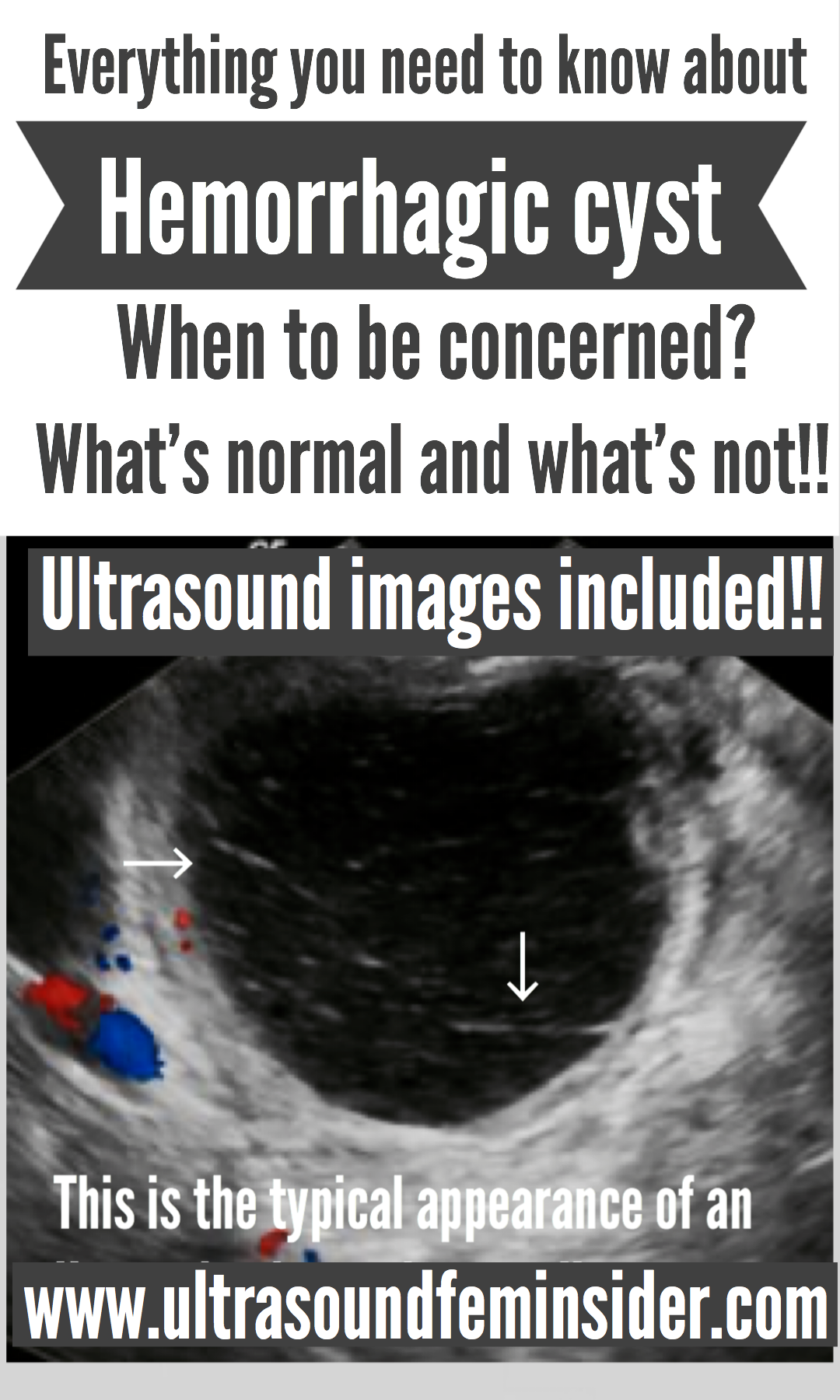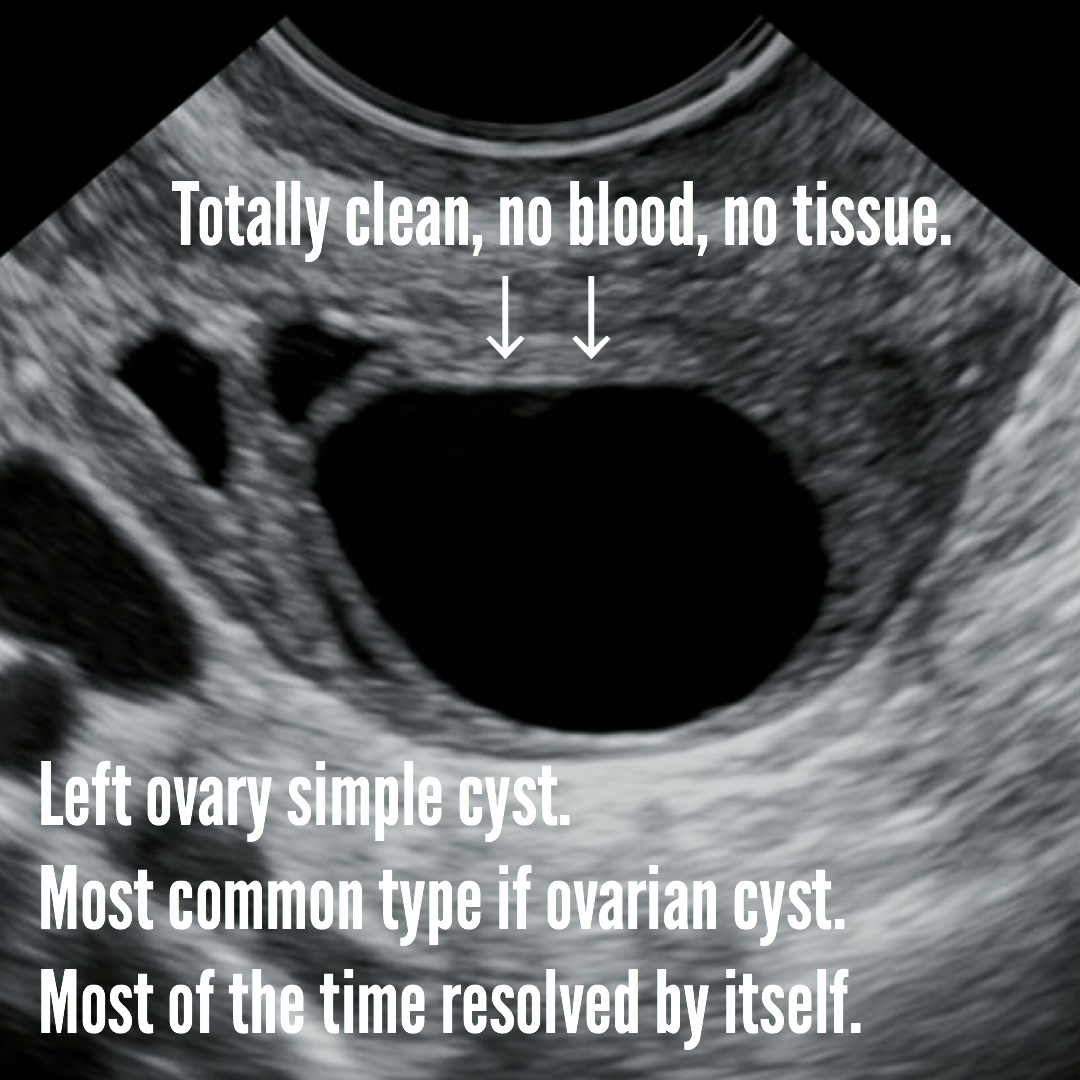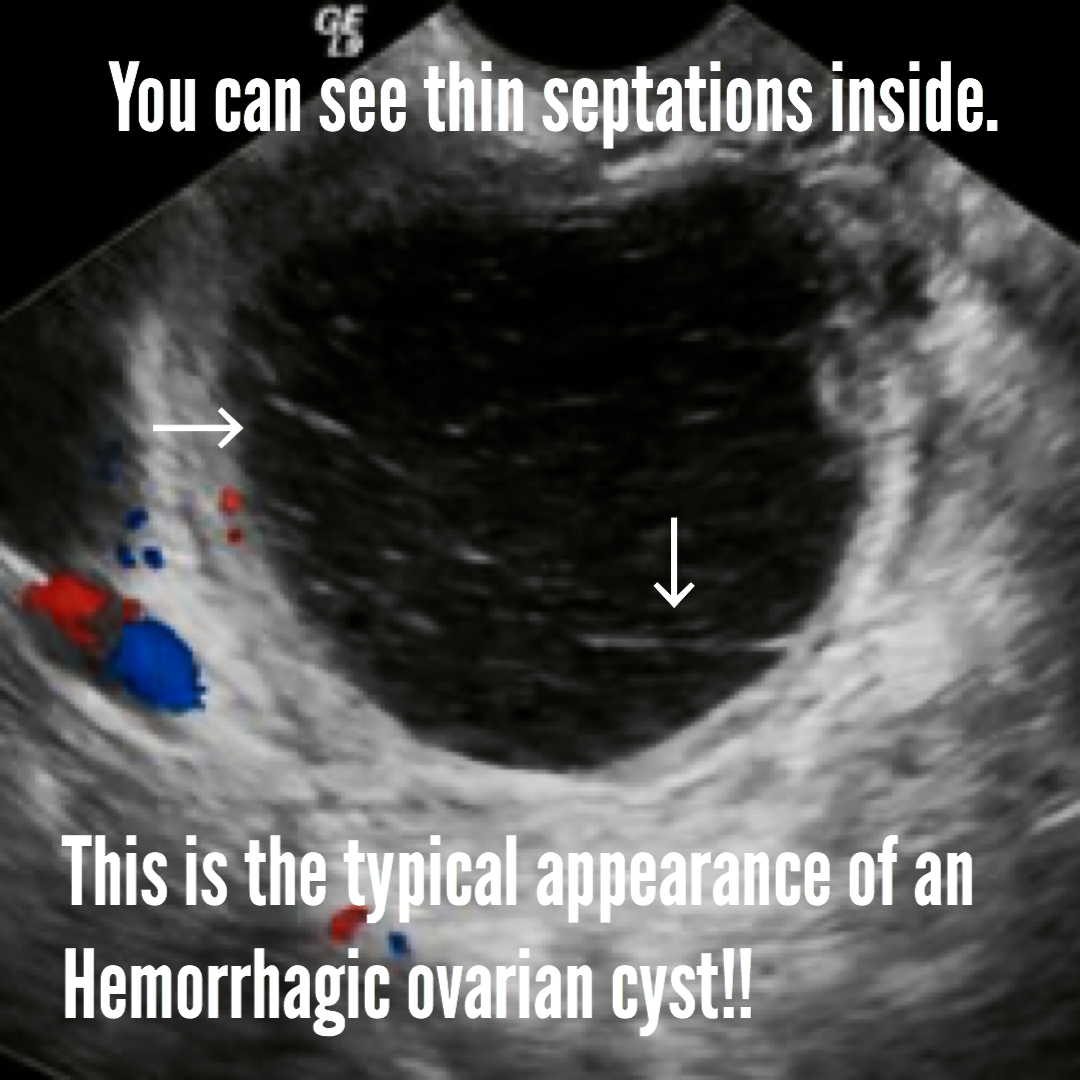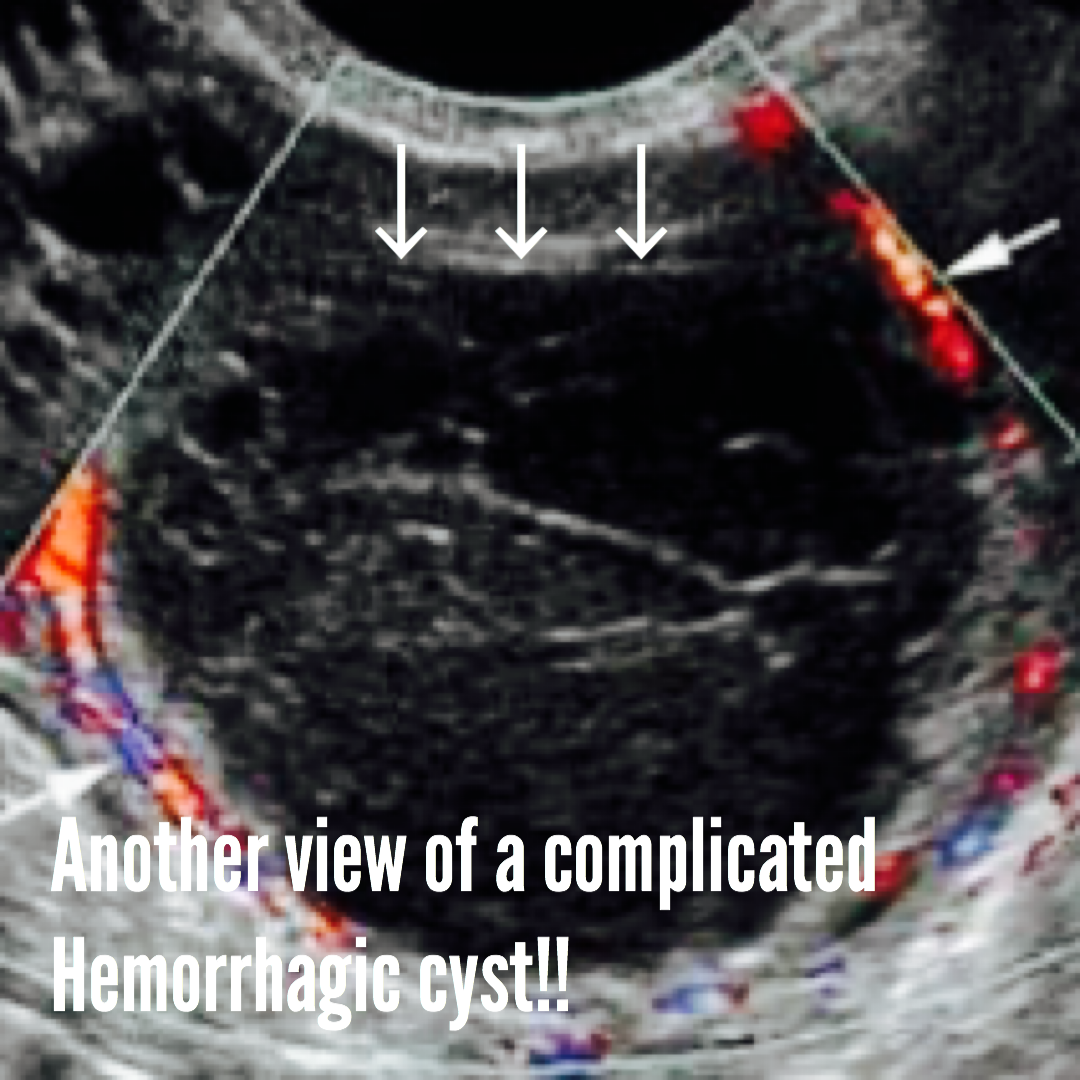Hemorrhagic cysts in the ovaries are considered functional cysts. Cysts, in a general sense, are closed sacs, that are usually filled with gas, fluid, and can sometimes contain solid components inside. Hemorrhagic cysts develop specifically in the ovaries. In this article I am going to give you all the information you should know about hemorrhagic cyst in the ovaries. We’ll discuss here about causes, symptoms, complications, risks factors, prevention, diagnosis, treatment and more. You will also find ultrasound images of hemorrhagic cysts. Ready? Let begin.
Cause of hemorrhagic cyst.
With the period each month, an egg is released into the fallopian tube. A small sac remains open, and it is usually filled with body fluid. This small sac seals by itself, and the liquid inside is reabsorbed by the body. This would be a simple cyst, which usually appears during menstrual periods, and disappears by themselves without the need for treatment or surgery. When a hemorrhage occurs inside this cyst, it occurs what is known as a hemorrhagic cyst.
The scientific explanation of the formation of a hemorrhagic cyst looks like this:
Hemorrhagic cyst occurs when a Graafian follicle ruptures to release an oocyte (egg) into the fallopian tube, it is then transformed into the corpus luteum. The corpus luteum is lined by a layer of granulose cells that rapidly become vascularized waiting to be fertilized; some of these thin-walled vessels can rupture inside the cyst, causing a hemorrhage. This causes bleeding into the corpus luteum, resulting in the formation of a hemorrhagic cyst of the ovary.
Symptoms for hemorrhagic cyst.
Although hemorrhagic cysts are considered functional (which means that they frequently occur as part of the function of the ovary, and they do not require intervention), it also produces symptoms that are sometimes worrisome for some women.
Among these symptoms are:
- Abdominal pains accompanied by bloating or a swelling sensation in the lower abdomen.
- May cause abnormal bleeding in between periods or irregular cycle changes.
- Lower back pains accompanied by inner thighs pain and pelvic pain.
- Breast tenderness.
- Nausea or vomiting due to the pain.
- Painful sexual intercourse.
- Difficulties in bowel movement.
- Sharp pelvic pain before and during the menstrual cycle.
As mentioned before, hemorrhagic cysts are entirely normal and are part of the menstrual period. Symptoms are varied, and for some women, it can be a cause for concern at times due to abnormal bleeding and pelvic pain. However, these cysts go away on their own without the need for treatment. Anyway, I want to list for you the reasons for when to be concerned and when to contact your doctor to further investigation?
Complications from hemorrhagic cysts might include.
Since the possibility of a ruptured cyst or ovarian torsion is always present, if the symptoms are severe, it is still good to rule out and perform an ultrasound.
A ruptured cyst occurs when a cyst grows and the capsule that covers it bursts, this can cause severe pain and bleeding.
An ovarian torsion occurs when a large cyst can cause the ovary to move, increasing the chance of painful twisting of your ovary (ovarian torsion).
- Sudden, severe abdominal or pelvic pain.
- Pain with fever or vomiting.
- Dizziness and fainting.
- Fatigued.
- Internal bleeding.
- Ovarian torsion can also decrease or stop blood flow to the ovaries.
Sharing is caring!

Risk factors for hemorrhagic cyst.
Even though hemorrhagic cysts are influenced by periods and hormones, some patients are at a higher risk of developing them, here are some of the risk groups for hemorrhagic cysts.
- Hormonal problems: These include taking the fertility drug known as clomiphene or (Clomid), which is used to cause you to stimulate the ovaries to ovulate. This treatment is used in patients with PCOS that will like to get pregnant.
- Pregnancy: Sometimes, the cyst that forms when you ovulate stays on your ovary throughout the first trimester of your pregnancy.
- A severe pelvic infection. If the infection spreads to the ovaries, it can cause cysts, especially hemorrhagic cysts.
- A previous ovarian cyst: If you’ve had one, you’re likely to develop more.
Prevention of hemorrhagic ovarian cysts.
Although there’s no way to prevent ovarian cysts, regular pelvic examinations help ensure that changes in your ovaries are diagnosed as early as possible.
- Be alert to changes in your monthly cycle, including unusual menstrual symptoms, especially ones that persist for more than a few periods. Talk to your doctor about changes that concern you.
Diagnosis of hemorrhagic cyst.
Several methods are used to diagnose hemorrhagic cysts. The most used by doctors today is vaginal pelvic ultrasound, since this diagnostic modality does not contain radiation, and it is 100% accurate to make the diagnosis.
Also, the doctor can perform other tests, such as:
- Serum CA-125 Assay: This test is performed to identify the underlying causes of the cyst if the possibility of cancer is suspected. During this blood test, an antigen is used alongside a blood sample, and if the level of CA-125 rises, then there could be potential of ovarian cancer.
- Hormone levels: Pregnancy and blood tests can be performed to check for hormones responsible for polycystic ovarian syndrome (PCOS).
Ultrasound images of hemorrhagic cyst with explanations.



Treatment of hemorrhagic cyst if is necessary.
As you probably noticed by now, the presence of a hemorrhagic cyst is not a cause for concern. However, after the first examinations, if the obtained result is an enlarged cyst, which exceeds 4 centimeters, and which also does not resolve after three menstrual cycles, then a treatment will be necessary to avoid other complications.
Within these treatments are:
In this case, the doctor can recommend the use of hormonal birth control pills. Accompanied by anti-inflammatory and pain killers such as ibuprofen can ease up the abdominal pains.
Surgery: Depends on the cyst size and potential of malignancy, various surgical procedures may be used to remove the cysts. Surgery may be a preferred option if:
- The cyst fails to go away and continues to grow large.
- The doctor suspects cancer after an ultrasound.
- You experience a lot of abdominal pain and your periods irregular.
- You are past menopause and at the risk of cancer.
Laparoscopic surgery
This involves identification and removal of the cyst whereby; an incision is made on the abdomen to allow a laparoscope to pass through into the ovaries and pick out the existing cyst.
Related posts:
Pelvic pain in women. Role of ultrasound diagnosing pelvic pain.
All about IUD or Intrauterine device.
Ovaries, hormonal cycles, and common cysts.
Final thoughts about Hemorrhagic cyst.
Many women have ovarian cysts at some time. Most ovarian cysts present little or no discomfort and are harmless. The majority disappears without treatment within a few months. However, ovarian cysts, especially those that have ruptured, can cause severe symptoms. To protect your health, get regular pelvic exams and know the signs that can signal a potentially serious problem.
I hope this article was helpful to you. Share your thoughts with our community in the comments.
Zadi, xo.
Disclaimer: The medical information on this post is for educational and entertainment use only. Under no circumstances, this information is to replace your doctor’s advice or to treat any disease. For proper care, always visit your doctor.










[…] Hemorrhagic cyst. When to be concerned. […]
[…] Hemorrhagic cyst. When to be concerned. […]
Hello there, just became alert to your blog through Google, and found that it’s truly informative. I? going to watch out for brussels. I will be grateful if you continue this in future. Many people will be benefited from your writing. Cheers!
Hello there! Do you know if they make any plugins to safeguard against hackers? I’m kinda paranoid about losing everything I’ve worked hard on. Any suggestions?
Try Wordfence plugin.
What? Happening i am new to this, I stumbled upon this I have found It absolutely useful and it has aided me out loads. I hope to contribute & assist other users like its helped me. Great job.
[…] Hemorrhagic cyst. Cause, symptoms, complications, ultrasound. […]
As a Newbie, I am continuously searching online for articles that can benefit me. Thank you